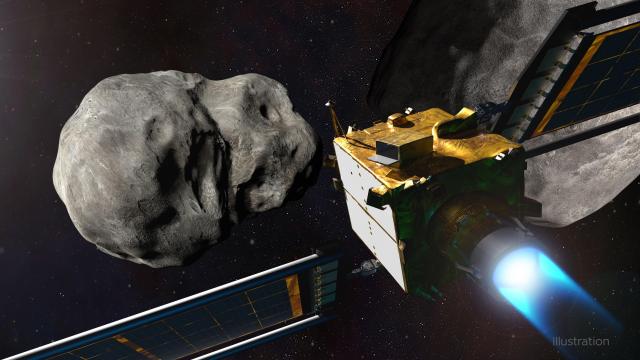The demise of DART is finally upon us, as the NASA spacecraft is on a collision course with the tiny Dimorphos asteroid. Here’s how you can watch this hugely important experiment to deflect an asteroid.
Short for Double Asteroid Redirection Test, the DART mission is the first test of kinetic impactor technology as a means of deflecting asteroids that could be headed towards Earth. Although Didymos means no harm to our planet, the epic crash could one day protect our planet from an Earth-bound asteroid. A lot is resting on this astronomical encounter, and here’s how you can watch the action live.
The DART spacecraft is scheduled to impact its target asteroid on Tuesday at 9:14 a.m. AEST. NASA will live stream the event at the space agency’s YouTube channel, the NASA app, and the agency’s website. Or you can stay right here and tune into the NASA broadcast through the feed below.
Live coverage of the mission kicked off at 8 a.m. AEST, and features audio from NASA’s mission control, live commentary, as well as images beamed down by the spacecraft’s onboard high-resolution camera, DRACO (Didymos Reconnaissance and Asteroid Camera for Optical navigation).
Excitingly, NASA is also providing a silent live feed from DRACO that began at 5 a.m. AEST on NASA’s media channel. DRACO will keep rolling until it finally smashes into Dimorphos, relaying one image per second back to ground controllers on Earth. You can also tune in to the DRACO feed through the live stream below.
DART is careening towards the asteroid at speeds reaching 22,531 km per hour. There may be a slight lag between these images and what’s happening in the control room as it takes about eight seconds for the images to appear on the screen after they’ve been received and processed by mission control, NASA officials told reporters during a press briefing on Thursday. So even if mission control declares “impact ” or “loss of signal,” it may take a few seconds to see that reflected in NASA’s coverage. And by “see it happen” we assume that’ll be the sudden appearance of a blank screen, signifying the destruction of the spacecraft.
DART is NASA’s first planetary defence test mission. Its target is a tiny asteroid known as Dimorphos, a mini-moon that orbits a slightly larger asteroid called Didymos. The 624 kg DART probe is going to smash into Dimorphos in an attempt to alter its orbit around its larger counterpart. The purpose of the test is to experiment with kinetic impactor technology as a means of deflecting asteroids that could be headed towards Earth.
NASA keeps a close watch on 28,000 nearby asteroids. Although none of those asteroids currently pose a threat to Earth, we do need a plan in place should a massive space rock be headed towards our planet in the future. Didymos and its tiny companion Dimorphos pose no threat to Earth, and the test won’t cause the system to threaten our planet. The pair is roughly 7 million miles (11 million kilometers) from Earth.
NASA will use ground-based telescopes to monitor Dimorphos’s orbital trajectory after being smacked by the spacecraft, and to also measure the physical effects of the impact itself. At the scene, Europe’s LICIACube will monitor the event with its two onboard cameras, LUKE and LEIA. The Hubble Space Telescope, the Webb Space Telescope, and a camera onboard the Lucy spacecraft, will also attempt to monitor the event.
The European Space Agency (ESA) is planning a follow-up mission to the pair of space rocks; the space agency is scheduled to launch its Hera mission in 2024, which will rendezvous with Didymos by 2026 to study the impact crater left behind by DART, and any other changes made to the asteroid.
For now, DART’s POV will hopefully provide a breathtaking view of Dimorphos as it heads directly into the asteroid. It’ll be a sad end to the spacecraft, but data from the mission could eventually result in the tools needed to deflect a legitimately dangerous asteroid.
What happens if it misses the asteroid? We explain that over here.
Additional reporting by George Dvorsky.
This article has been updated since it was first published.
